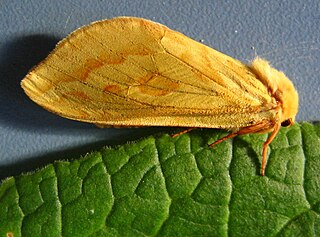
The Hepialidae are a family of insects in the lepidopteran order. Moths of this family are often referred to as swift moths or ghost moths.

The ghost moth or ghost swift is a moth of the family Hepialidae. It is common throughout Europe, except for in the far south-east.

Phassodes is a moth genus of the family Hepialidae. As of 2018, it is monospecific, consisting of the sole species Phassodes vitiensis; this species is very variable. It is found in Fiji and Samoa. The life cycle is unknown but the larva is presumed to feed underground on the roots of plants or decaying matter.

Abantiades latipennis, known as the Pindi moth, is a species of moth in the family Hepialidae. It may also be referred to as a swift moth or a ghost moth, as this is a common name associated with Hepialidae. Endemic to Australia and identified in 1932, it is most populous in temperate rainforest where eucalypti are prevalent, as the larvae feed primarily on the roots of these trees. Females lay eggs during flight in a scattering fashion. The larvae live for over eighteen months underground, while adult moths survive for approximately one week, as they have no mouthparts with which to feed. The moths are preyed upon by a number of predators, including bats and owls. Brown in colour overall, males are paler and the identifying silver bars of the male's wings are more prominent than those of the female's, with dark margins. Male adults are generally smaller.
Cibyra exclamans is a species of moth of the family Hepialidae. It is known from Brazil.
Cibyra munona is a species of moth of the family Hepialidae. It is known from Brazil.
Cibyra pittionii is a species of moth of the family Hepialidae. It is known from Brazil.
Cibyra saguanmachica is a species of moth of the family Hepialidae. It is known from Colombia.
Cibyra spitzi is a species of moth of the family Hepialidae. It is known from Brazil.
Cibyra terea is a species of moth of the family Hepialidae. It is known from Panama and Mexico.
Cibyra trilinearis is a species of moth of the family Hepialidae. It is known from Colombia.
Phassus pharus is a moth of the family Hepialidae first described by Herbert Druce in 1887. It is known from Guatemala. Food plants for this species include Malvaceae and grasses such as sugar cane.

Sthenopis pretiosus, the gold-spotted ghost moth, is a species of moth of the family Hepialidae. It was first described by Gottlieb August Wilhelm Herrich-Schäffer in 1856. It can be found in found Brazil, Venezuela and in the north-eastern United States and south-eastern Canada.
Ahamus anomopterus is a species of moth of the family Hepialidae. It was described by D.R. Yang in 1994, and is known from Yunnan, China.
Ahamus jianchuanensis is a species of moth of the family Hepialidae. It was described by Yang in 1994, and is known from Yunnan, China.
Ahamus lijiangensis is a species of moth of the family Hepialidae. It was described by Hong-Fu Chu and Lin-Yao Wang in 1985 and is known from Yunnan, China.
Ahamus luquensis is a species of moth of the family Hepialidae. It was described by D.R. Yang in 1995, and is known from Gansu, China.
Ahamus menyuanicus is a species of moth of the family Hepialidae. It was described by Hong-Fu Chu and Lin-Yao Wang in 1985 and is known from Qinghai, China.
Ahamus yunlongensis is a species of moth of the family Hepialidae. It was described by Hong-Fu Chu and Lin-Yao Wang in 1985 and is known from Yunnan, China.
Ahamus yunnanensis is a species of moth of the family Hepialidae. It was described by D.R. Yang, C.D. Li and C. Shen in 1992, and is known from Yunnan, China, from which its species epithet is derived.




